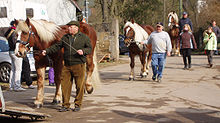Heilbronn horse market


The Heilbronn horse market is one of the largest traditional fairs held in a German city center and is the first larger market of the year in the Heilbronn region . Its tradition dates back to 1770. At that time, the mayor Georg Heinrich von Roßkampff introduced the annual cattle and horse market at the Heilbronn shooting range .
history
The necessity of such a market had arisen since the late Middle Ages, since for political reasons it was mostly forbidden for the Heilbronn butchers to trade cattle in the surrounding territories (Württemberg, Kurpfalz, Deutscher Orden). Instead, the people of Heilbronn had to travel all the way to the ox fair in Bamberg for their cattle shops . The first attempt to establish its own Heilbronn cattle market failed in 1692 due to the effects of the Third War of the Palatinate Succession . Only in the second half of the 18th century, which was economically favorable for the city, were the conditions for the establishment of an important market in place. Mayor Georg Heinrich von Roßkampff (1720-1794), who came into office in 1769 and 25 years of mayor remained, leaving the end of February 1770 the first cattle and horse market in the Hammel Wasen hold. Roßkampff had already proven to be a promoter of agriculture and cattle breeding when he introduced alfalfa as a fodder plant from southern France in 1765 and promoted the refinement of cattle on the municipal farms. A cattle market that was respected nationwide should help to publicize the high-quality Heilbronn breeding cattle and to open up new sales opportunities. The first market in February 1770 was such a success that the city council decided to hold three such markets a year. In addition, it was immediately decided to erect a representative building, the shooting house , built in 1771 , on the market. With the cattle market, an attached grocer's and craftsmen's market quickly developed, as grocers and craftsmen saw a welcome clientele in the farmer who were well off after the sale of cattle. A separate market regulation was issued for shopkeepers and craftsmen in 1772 .
In the 19th century, the Heilbronn cattle market gained central importance in northern Württemberg, also benefiting from the fact that livestock farming was becoming increasingly important in agriculture at that time. The number of cattle markets held annually in Heilbronn had increased to eight by 1891. In 1865 the size of the Heilbronn market in the rest of Württemberg was only exceeded by the Upper Swabian markets in Biberach an der Riss and Ravensburg , and around 10,000 cattle and 3,000 pigs changed hands in Heilbronn every year. In 1879, in the immediate vicinity of the market area on the Hammelwasen, the municipal slaughterhouse was built, which was considered to be one of the most modern facilities in the wide area, both in terms of its size and machines, as well as its cooling with artificial ice.
Towards the end of the 19th century, a wave of price increases for slaughter cattle began, which culminated in 1906 in the uniform setting of meat prices within the Heilbronn butchers' guild, which has since been established. At the same time, foot and mouth disease had a negative impact on the livestock trade. The livestock market quickly lost its importance and the market event was largely geared towards the horse trade , which had previously only played a subordinate role. In 1902, only about 25 low-quality horses were fed to each of the cattle markets. With the new conception of a horse market held once a year on the last Monday in February with a higher quality range, the wagon builders and saddlers in particular promised a higher turnover.
In 1906 the horse market with the attached wagon and saddlery market was relocated to the Wollhaus in the city center. At the first market on the new square, 253 of the 550 horses were sold; the highest price was 4400 marks for a couple. The markets were discontinued during World War I and only resumed in 1923. In 1927 a general grocer's market was added again. The last horse market before the Second World War took place in 1939; the event was canceled in the war and the first post-war years. On February 27, 1950, the first horse market after the Second World War was opened. In 1970 80,000 visitors were counted. At that time, 250 dealers and 45 exhibitors of agricultural implements and machines filled the market. The range of farm animals was limited to 25 horses and three donkeys, 130 breeding horses took part in the horse awards. In 1976 Saturday was added as the third market day.
Current
The Heilbronn horse market takes place on three days over the last weekend in February. On Saturday and Sunday around 200 to 300 horses compete for the various awards at the Trappensee , on Monday there are still horses for sale, albeit in significantly fewer numbers than in earlier times. In addition, a grocer's market including rides will be set up on all three days in downtown Heilbronn .
In 2006 around 150,000 people visited the horse market with around 350 dealers and exhibitors.
literature
- Helmut Schmolz: 200 years of Heilbronn cattle and horse market . In: Swabia and Franconia. Local history supplement of the Heilbronn voice . 16th year, no. 1 . Verlag Heilbronner Demokratie , Heilbronn 1970 (continued in No. 2. ZDB -ID 128017-x ).
- Ernst Schmid: The commercial development in the city of Heilbronn since the beginning of industrialization. Stadtarchiv Heilbronn, Heilbronn 1993, ISBN 3-928990-39-X ( Sources and research on the history of the city of Heilbronn. Volume 3)



